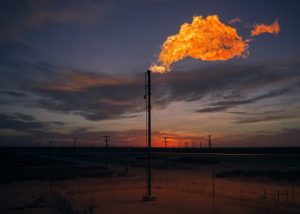 Routine flaring in Texas is, well, too routine. It’s wasteful, harmful for health and the climate, and getting permission to burn gas instead of finding a productive use for it is far too easy in our state. Over 1 trillion cubic feet of Texas gas have been vented or flared by operators in the past decade — as much gas as 14 million Texas households use in an entire year.
Routine flaring in Texas is, well, too routine. It’s wasteful, harmful for health and the climate, and getting permission to burn gas instead of finding a productive use for it is far too easy in our state. Over 1 trillion cubic feet of Texas gas have been vented or flared by operators in the past decade — as much gas as 14 million Texas households use in an entire year.
Under mounting pressure from investors, communities and oil and gas operators, factions of industry have made recent public commitments to reduce this wasteful practice. For example, the Texas Methane and Flaring Coalition announced a collective goal to end routine flaring in Texas by 2030.
This may sound like progress, but in reality it’s yet another decade of wasteful flaring and a pledge that comes with no commitment to the regulatory changes vital to make it happen statewide. We can’t wait that long.
Routine flaring in Texas needs to end — and if the Railroad Commission won’t step up, Texans are going to need the U.S. Environmental Protection Agency to advance solutions and protect our health and climate.
As Texas fails to stop flaring, EPA must act Share on XEPA is now drafting national methane standards that could eliminate routine venting and flaring—a major source of climate and health-harming pollution—as a broad, diverse group of 72 environmental and community groups from across Texas and the U.S. asked the agency to do just last week. Texas is the poster child for why that policy action is so important.
Catering to industry’s worst actors
It is true that since the covid crisis began in 2020, due to factors largely beyond anyone’s control, Permian flaring and intensity have declined. However, rates of unlit and malfunctioning flares have remained unacceptably high, with industry failing to keep one in every 10 flares properly lit.
It is also true that there’s nothing on the books in Texas that legally stops operators from ramping flaring up again when oilfield economics change — and equally true that there are still too many operators flaring at high rates today. In fact, even in 2020, more than 90 Texas oil and gas companies reported that they flared over 90% of the gas their wells produced — and 188 companies flared over 10%. Recent reports have raised serious questions about how often flares are accurately reported and permitted. Not all companies are this irresponsible or wasteful, in fact data indicates flaring below 1% appears to be an achievable goal for most companies by 2025. But it’s clear that commitments from a few don’t translate to responsible behavior by all.
In addition to voluntary commitments from responsible companies, Texas needs flaring rules that level the playing field and ensure we achieve the cuts in pollution and waste Texans deserve as swiftly as possible.
Texas refuses to modernize and EPA must take action
Ending routine flaring is not only smart and responsible, it’s cost-effective. In an analysis commissioned by EDF, Rystad Energy found that 84% of routine flaring volumes in the Texas Permian could be mitigated without cost and that operators would realize an additional $400 million of wellhead value by 2025 if they were to capture 98% of the gas they produce. If the Texas Railroad Commission truly wanted to “reduce flaring of natural gas in Texas,” it would adopt a commonsense rule to end this wasteful practice.
Texas is behind the times, and the rest of the world is taking notice. Investors representing $14 trillion in assets under management have endorsed ending routine flaring in Texas or nearly eliminating flaring by 2025. Concerns about the “dirtiness” of Texas gas lost the state a $7 billion international gas deal.
Ending routine flaring is no longer groundbreaking or without precedent. Companies like BP are establishing a new baseline expectation for oil production in Texas by pledging not to drill a well without gas gathering infrastructure in place — ending all routine flaring from their Permian assets.
What’s more, major oil and gas producing states like Colorado and New Mexico have shown that ending routine flaring is entirely possible. Both states recently finalized rules to eliminate the practice of routine venting and flaring at new and existing wells.
With the Texas RRC refusing to acknowledge the health, environmental and economic threat that routine flaring poses, EPA needs to step in and put us on a path to quickly end this reckless practice.









